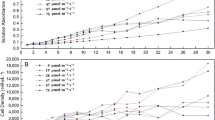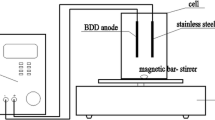Abstract
Effects of electrolysis by low-amperage electric current on the chlorophyll fluorescence characteristics of Microcystis aeruginosa were investigated in order to reveal the mechanisms of electrolytic inhibition of algae. Threshold of current density was found under a certain initial no. of algae cell. When current density was equal to or higher than the threshold (fixed electrolysis time), growth of algae was inhibited completely and the algae lost the ability to survive. Effect of algal solution volume on algal inhibition was insignificant. Thresholds of current density were 8, 10, 14, 20, and 22 mA cm−2 at 2.5 × 107, 5 × 107, 1 × 108, 2.5 × 108, and 5 × 108 cells mL−1 initial no. of algae cell, respectively. Correlativity between threshold of current and initial no. of algae cells was established for scale-up and determining operating conditions. Changes of chlorophyll fluorescence parameters demonstrated that photosystem (PS) II of algae was damaged by electrolysis but still maintained relatively high activity when algal solution was treated by current densities lower than the threshold. The activity of algae recovered completely after 6 days of cultivation. On the contrary, when current density was higher than the threshold, connection of phycobilisome (PBS) and PS II core complexes was destroyed, PS II system of algae was damaged irreversibly, and algae could not survive thoroughly. The inactivation of M. aeruginosa by electrolysis can be attributed to irreversible separation of PBS from PS II core complexes and the damage of PS II of M. aeruginosa.






Similar content being viewed by others
References
Alfafara CG, Nakano K, Nomura N, Igarashi T, Matsumura M (2002) Operating and scale-up factors for the electrolytic removal of algae from eutrophied lakewater. J Chem Technol Biotechnol 77:871–876
Feng C, Sugiura N, Shimada S, Maekawa T (2003) Development of a high performance electrochemical wastewater treatment system. J Hazard Mater 103:65–78
Feng C, Suzuki K, Zhao S, Sugiura N, Shimada S, Maekawa T (2004) Water disinfection by electrochemical treatment. Bioresour Technol 94:21–25
Francois P, Abdallah O, Laura P, Louka S, William GM, Radovan P (2010) Evaluation of copper oxide nanoparticles toxicity using chlorophyll a fluorescence imaging in Lemna gibba. J Bot. doi:10.1155/2010/763142
Govindjee (1995) Sixty-three years since Kautsky: chlorophyll a fluorescence. Aust J Plant Physiol 22:131–160
Han BP, Virtanen M, Koponen J, Straskraba M (2000) Effect of photoinhibition on algal photosynthesis: a dynamic model. J Plankton Res 22:865–885
Heraud P, Beardall J (2000) Changes in chlorophyll fluorescence during exposure of Dunaliella tertiolecta to UV radiation indicate a dynamic interaction between damage and repair processes. Photosynth Res 63:123–134
Inoue N, Taira Y, Emi T, Yamane Y, Kashino Y, Koike H, Satoh K (2001) Acclimation to the growth temperature and the high-temperature effects on photosystem II and plasma membranes in a mesophilic cyanobacterium, Synechocystis sp. PCC6803. Plant Cell Physiol 42:1140–1148
Kolber Z, Zehr J, Falkowski P (1988) Effects of growth irradiance and nitrogen limitation on photosynthetic energy conversion in photosystem II. Plant Physiol 88:923–929
Kramer DM, Johnson G, Kiirats O, Edwards GE (2004) New fluorescence parameters for the determination of QA redox state and excitation energy fluxes. Photosynth Res 79:209–218
Li Y, Li C, Zheng Y, Wu G, Wuyun T, Xu H, He X, Jiang G (2011) Cadmium pollution enhanced ozone damage to winter wheat: biochemical and physiological evidences. J Environ Sci 23:255–265
Liang WY, Qu JH, Chen LB, Liu HJ, Lei PJ (2005) Inactivation of Microcystis aeruginosa by continuous electrochemical cycling process in tube using Ti/RuO2 electrodes. Environ Sci Technol 39:4633–4639
Lin L, Li QY, Huang Z, Wu M (2012) Research of Microcystis aeruginosa’s inactivation and inhibition by micro-current electrolysis. J Huazhong Univ Sci Technol (Nat Sci Ed) 40:87–90 (in Chinese)
Macinnis-Ng CMO, Ralphsd PJ (2003) In situ impact of petrochemicals on the photosynthesis of the seagrass Zostera capricorni. Mar Pollut Bull 46:1395–1407
Martinez-Huitle CA, Brillas E (2008) Electrochemical alternatives for drinking water disinfection. Angew Chem Int Ed 47:1998–2005
Massacci A, Nabiev SM, Pietrosanti L, Nematov SK, Chernikova TN, Leipner KTAJ (2008) Response of the photosynthetic apparatus of cotton (Gossypium hirsutum) to the onset of drought stress under field conditions studied by gas-exchange analysis and chlorophyll fluorescence imaging. Plant Physiol Biochem 46:189–195
Maxwell K, Johnson GN (2000) Chlorophyll fluorescence—a practical guide. J Exp Bot 51:659–668
Monitoring and analyzing methods for water and waste water (the fourth edition). (2002) Beijing: China Environmental Science Press, pp 670–671.
Muller R, Schreiber U, Escher BI, Quayle P, Nash SMB, Mueller JF (2008) Rapid exposure assessment of PSII herbicides in surface water using a novel chlorophyll a fluorescence imaging assay. Sci Total Environ 401:1–3
Nanayakkara KGN, Zheng Y-M, Alam AKMK, Zou S, Chen JP (2011) Electrochemical disinfection for ballast water management: technology development and risk assessment. Mar Pollut Bull 63:119–123
Olvera-Ramírez R, Coria-Cedillo M, Cañizares-Villanueva RO, Martínez-Jerónimo F, Ponce-Noyola T, Ríos-Leal E (2000) Growth evaluation and bioproducts characterization of Calothrix sp. Bioresour Technol 72:121–124
Paerl HW, Otten TG (2013) Harmful cyanobacterial blooms: causes, consequences, and controls. Microb Ecol 65:995–1010
Perreault F, Oukarroum A, Pirastru L, Sirois L, Matias WG, Popovic R (2010) Evaluation of copper oxide nanoparticles toxicity using chlorophyll a fluorescence imaging in Lemna gibba. J Bot. doi:10.1155/2010/763142
Rizza F, Pagani D, Stanca AM, Cattivelli L (2001) Use of chlorophyll fluorescence to evaluate the cold acclimation and freezing tolerance of winter and spring oats. Plant Breed 120:389–396
Schlensog M, Schroeter B (2001) A new method for the accurate in situ monitoring of chlorophyll a fluorescence in lichens and bryophytes. Lichenologist 33:443–452
Schreiber U, Quayle P, Schmidt S, Escher BI, Mueller JF (2007) Methodology and evaluation of a highly sensitive algae toxicity test based on multiwell chlorophyll fluorescence imaging. Biosens Bioelectron 22:2554–2563
Shi H-X, Qu J-H, Wang A-M, Ge J-T (2005) Degradation of microcystins in aqueous solution with in situ electrogenerated active chlorine. Chemosphere 60:326–333
Woo NS, Badger MR, Pogson BJ (2008) A rapid, non-invasive procedure for quantitative assessment of drought survival using chlorophyll fluorescence. Plant Methods 4:27–40
Xu Y, Yang J, Ou M, Wang Y, Jia J (2007) Study of Microcystis aeruginosa inhibition by electrochemical method. Biochem Eng J 36:215–220
Yamane Y, Kashino Y, Koike H, Satoh K (1997) Increases in the fluorescence Fo level and reversible inhibition of photosystem II reaction center by high-temperature treatments in higher plants. Photosynth Res 52:57–64
Yuan SH, Kang J, Chen J, Wu XF, Lu XH (2010) Development of a novel internal electrolysis system by iron connected with carbon: treatment of nitroaromatic compounds and case of engineering application. J Environ Eng ASCE 136:975–982
Acknowledgments
This study was funded by the National Natural Science Foundation of China (Grant 51309019, 51379016), Ministry of Water Resource, Public Interest Scientific Research Fund (No. 201501019), Ministry of Science and Technology, Technology Research and Development Special Funds of Scientific Research Institute (Grant 2012EG136134). We thank Mr. Zhongxian Lv from Zealquest Scientific Technology Co., Ltd. for his help on the analysis of chlorophyll fluorescence parameters of M. aeruginosa. We also thank Dr. Ming Li from Northwest Agriculture and Forestry University for his help on the revision of the manuscript.
Author information
Authors and Affiliations
Corresponding author
Additional information
Responsible editor: Philippe Garrigues
Rights and permissions
About this article
Cite this article
Lin, L., Feng, C., Li, Q. et al. Effects of electrolysis by low-amperage electric current on the chlorophyll fluorescence characteristics of Microcystis aeruginosa . Environ Sci Pollut Res 22, 14932–14939 (2015). https://doi.org/10.1007/s11356-015-4708-z
Received:
Accepted:
Published:
Issue Date:
DOI: https://doi.org/10.1007/s11356-015-4708-z




